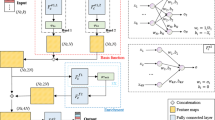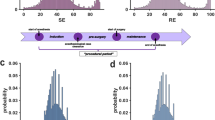Abstract
Model-based reconstruction of electrical brain activity from electro-encephalographic measurements is of growing importance in neurology and neurosurgery. Algorithms for this task involve the solution of a 3D Poisson problem on a realistic head geometry obtained from medical imaging. In the model, several compartments with different conductivities have to be distinguished, leading to a problem with jumping coefficients. Furthermore, the Poisson problem needs to be solved repeatedly for different source contributions. Thus efficient solvers for this subtask are required. Experience with different iterative solvers is reported, i.e. successive over-relaxation, (preconditioned) conjugate gradients and algebraic multigrid, for a discretisation based on cell-centred finite differences. It was found that: first, the multigrid-based solver performed the task 1.8–3.5 times faster, depending on the platform, than the second-best contender; secondly, there was no need to introduce a reference potential that forced a unique solution; and, thirdly, neither the grid-nor matrix-based implementation of the solvers consistently gave a smaller run time.
Similar content being viewed by others
References
Baillet, S., Mosher, J. C., andLeahy, R. M. (2001): ‘Electromagnetic brain mapping’,IEEE Signal Process. Mag.,18, pp. 14–30
Barrett, R., Berry, M., Chan, T. F., Demmel, J., Donato, J., Dongarra, J., Eijkhout, V., Pozo, R., Romine, C., andVan Der Vorst, H. V. (1994): ‘Templates for the solution of linear systems: building blocks for iterative methods, 2nd edn’ (SIAM, Philadelphia, PA, 1994)
Berman, A., andPlemmons, R. (1994): ‘Nonnegative matrices in the mathematical sciences’. Number 9 in Classics in applied mathematics (SIAM, 1994)
Boon, P., D'havé, M., Van Hoey, G., Vanrumste, B., Vonck, K., Adam, C., Vandekerckhove, T., Michielsen, G., Baulac, M., andDe Reuck, J. (1999): ‘Source localization in refractory partial epilepsy’,Revue Neurologique,155, pp. 499–508
Briggs, W. L., Henson, V. E., andMcCormick, S. F. (2000): ‘A multigrid tutorial, 2nd edn’ (SIAM, 2000)
Buchner, H., Knoll, G., Fuchs, M., Rienäcker, A., Beckmann, R., Wagner, M., Silny, J., andPesch, J. (1997): ‘Inverse localization of electric dipole current sources in finite element models of the human head’,Electroencephalogr. Clin. Neurophysiol.,102, pp. 267–278
Goedecker, S., andHoisie, A. (2001): ‘Performance optimization of numerically intensive codes’ (SIAM, 2001)
Hackbusch, W. (1992): ‘Elliptic differential equations: theory and numerical treatment’ in ‘Series in computational mathematics’ (Springer, 1992), Vol. 18
Hackbusch, W. (1994): ‘Iterative solution of large sparse systems of equations’ in ‘Applied mathematical sciences’ (Springer, 1994), Vol. 95
Henson, V. E., andYang, U. M. (2002): ‘BoomerAMG: A parallel algebraic multigrid solver and preconditioner’,Appl. Numer. Math.,41, pp. 155–177 (also available as Lawrence Livermore National Laboratory technical report UCRL-JC-141495)
Hoekema, R., Venner, K., Struijk, J., andHolsheimer, J. (1998): ‘Multigrid solution of the potential field in modeling electrical nerve stimulation’,Comput. Biomed. Res.,31, pp. 348–362
Jasper, H. (1958): ‘Report of committee on methods of clinical exam in EEG’,Electroencephalogr. Clin. Neurophysiol.,10, pp. 370–375
Lopes da Silva, F. (1987): ‘Event-related potentials: Methodology and quantification’ inNieder Meyer, E., andLopes da Silva, F. (Eds): ‘Electroencephalography, basic principles, clinical applications and related fields, 2nd edn’ (Urban and Schwarzenberg, 1987), Chap. 46, pp. 763–772
Loshin, D. (1998): ‘Efficient memory programming’ (McGraw-Hill, 1998)
Meijerink, J. A., andvan der Vorst, H. A. (1977): ‘An iterative solution method for linear systems of which the coefficient matrix is a symmetric M-matrix’,Math. Comput.,31, pp. 148–162
Mitchell, A., andGriffiths, D. (1980): ‘The finite difference method in partial differential equations’ (John Willey Sons, 1980)
Mohr, M. (2001): ‘Comparison of solvers for a bioelectric field problem.’ Technical report 01–2, Lehrstuhl für Informatik 10 (Systemsimulation), Friedrich-Alexander-Universität Erlangen-Nürnberg. Available on: www10.informatik.uni-erlangen. de/∼mohr/
Oostendorp, T. F., Delbeke, J., andF. S. D. (2000): ‘The conductivity of the human skull: Results ofin vivo andin vitro measurements’,IEEE Trans. Biomed. Eng.,47, pp. 1487–1492
Plonsey, R., andHeppner, D. B. (1967): ‘Considerations of quasistationarity in electrophysiological systems’,Bull. Math. Biophys.,29, pp. 657–664
Ruge, J. W., andStüben, K. (1987): ‘Algebraic multigrid (AMG)’ inMcCormick, S. F. (Ed.): ‘Multigrid methods’, ‘Frontiers in applied mathematics’ (SIAM, 1987), Vol. 3, pp. 73–130
Saleheen, H. I., andNg, K. T. (1997): ‘New finite difference formulations for general inhomogeneous anisotropic bioelectric problems’,IEEE Trans. Biomed. Eng.,44, pp. 800–809
Tuch, D., Wedeen, V., Dale, A., George, J., andBelliveau, T. (1999): ‘Conductivity mapping of biological tissue using diffusion MRI’ Proc. Third Int. Conf. on Occupational electrical injury & safety, Shanghai, China, 26–28 October, 1998,888,Ann. New York Acad. Sci., pp. 314–316
Vanrumste, B. (2001): ‘EEG dipole source analysis in a realistic head model.’ PhD thesis, Faculty of Engineering, Gent University. Available on: http://www.elec.canterbury.ac.nz/staff/visitors/ bart/bvr_home.htm
Vanrumste, B., Van Hoey, C., Van de Walle, R., D'Havé, M., Lemahieu, I., andBoon, P. (2001): ‘The validation of the finite difference method and reciprocity for solving the inverse problem in EEG dipole source analysis’,Brain Topogr.,14, pp. 83–92
Varga, R. (1962): ‘Matrix iterative analysis’ in ‘Series in Automatic Computation’ (Prentice-Hall, 1962)
Weinstein, D., Zhukov, L., andJohnson, C. (2000): ‘Lead-field bases for electroencephalography source imaging’,Ann. Biomed. Eng.,28, pp. 1059–1065
Wolters, C., Reitzinger, S., Basermann, A., Burkhardt, S., Hartmann, U., Kruggel, F., andAnwander, A. (2001): ‘Improved tissue modelling and fast solver methods for high-resolution FE-modelling in EEG/MEG-source localization’ inNenonen, J., Ilmoniemi, R., andKatila, T. (Eds): ‘Biomag 2000’. Proceedings of 12th International Conference on Biomagnetism
Author information
Authors and Affiliations
Corresponding author
Rights and permissions
About this article
Cite this article
Mohr, M., Vanrumste, B. Comparing iterative solvers for linear systems associated with the finite difference discretisation of the forward problem in electro-encephalographic source analysis. Med. Biol. Eng. Comput. 41, 75–84 (2003). https://doi.org/10.1007/BF02343542
Received:
Accepted:
Issue Date:
DOI: https://doi.org/10.1007/BF02343542




